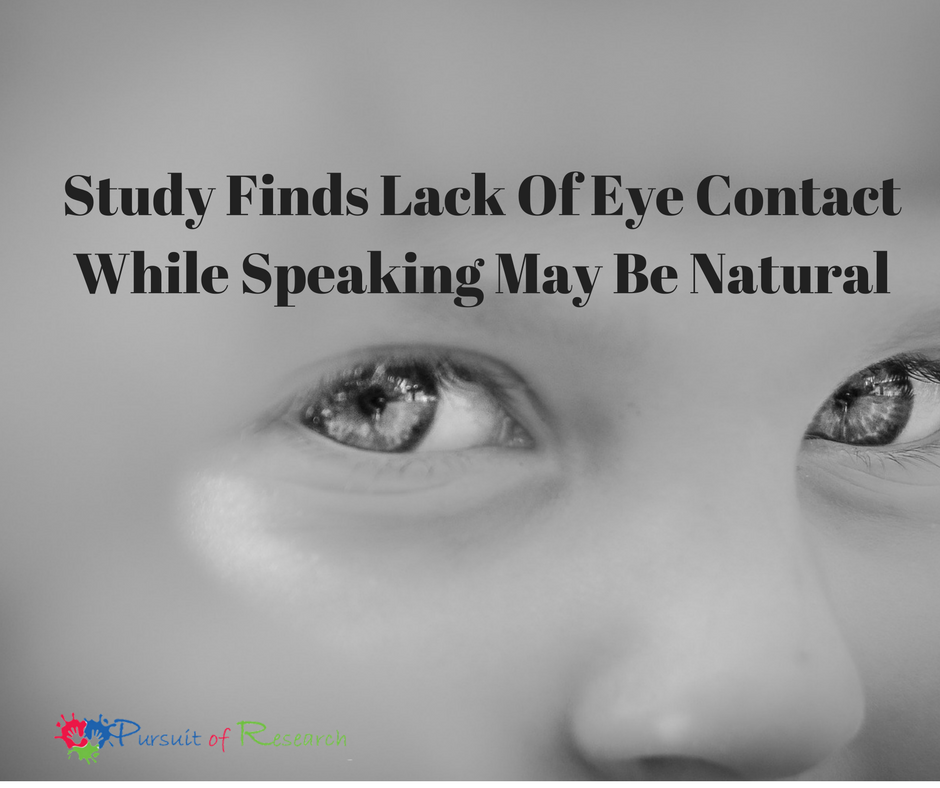In watching YouTube videos of children with apraxia for example many times you’ll see their gaze glance up or down while speaking. I had been pointing this out for over a decade, but now there is research that explains why this is a natural behavior in anyone.
 Your child is a late talker, or maybe has a diagnosis of a speech impairment like apraxia. You’re worried about the lack of eye contact while your child is trying to talk to you, as if they are finding it hard to both talk and look you in the eye at the same time.
Your child is a late talker, or maybe has a diagnosis of a speech impairment like apraxia. You’re worried about the lack of eye contact while your child is trying to talk to you, as if they are finding it hard to both talk and look you in the eye at the same time.
We hear about lack of eye contact in regards to autism, but new research has found that all people have trouble maintaining eye contact if they are sharing something that they have to think about or concentrate on.
In a new study just published in the journal Cognition, a pair of Japanese researchers with Kyoto University, say that this happens because eye contact has a “unique effect” on our “cognitive control processes”. Shogo Kajimura and Michio Nomura describe experiments they carried out with volunteers to learn more about how the phenomenon works and then discuss their findings. Essentially they found that mutual gaze is so mentally stimulating that it can be tricky to think straight and maintain eye contact at the same time.
Try this: Have someone ask you a math problem you can figure out in your head and have you try to answer them without breaking eye contact. You will find it’s difficult if you can do it at all.
Past research has shown that eye contact interferes with other mental tasks such as those involving visual imagination. Arguably this isn’t so surprising because both eye contact and visual imagination are obviously tapping the same mental domain.
Even though most of us are aware that maintaining eye contact with another person while speaking can at times be difficult, when we have a child with a communication impairment we expect that eye contact.
In watching YouTube videos of children with apraxia for example many times you’ll see their gaze glance up or down while speaking. I had been pointing this out for over a decade, but now there is research that explains why this is a natural behavior in anyone. Here is an example with Tanya’s then 4 year old son Colton who was diagnosed with apraxia. You’ll see certain times where he is thinking about what he needs to say where he has no eye contact, and other times where his eye contact is excellent.
Now this new study shows that lack of eye contact while talking, even in neurotypical adults, can be natural. While there may be various reasons for looking away during a conversation, such as growing bored of a conversation, awkwardness, sometimes, as the researchers suggest, it is because we are trying to keep our brains from overloading.
To better understand what is going on in the brain during conversation, the researchers enlisted the assistance of 26 volunteers who were asked to participate in a common word-association game in which a person was shown a word (a noun) and was then asked to offer an immediate response (a verb), e.g. when given the word “ball,” a reply might be the word “throw.” In the lab, the volunteers interacted with a face on a computer (that sometimes looked away) as they played the game with different types of words that the researchers had preselected—some were easy while others were more difficult—coming up with a verb for “sky,” for example, can be difficult for some because of the lack of choices, while coming up with a response to a word like “leaf” may be difficult because it has so many options to choose from.
The researchers then compared responses to the words with how long it took a volunteer to respond and their tendency to break eye contact.
They found that the volunteers were likely to take more time when responding to harder words, but not as much time if they broke eye contact. This, the research pair suggest, indicates that the dual task of maintaining eye contact (and the inherent intimate connection it involves) while also racking the brain for a word to meet the request is just too demanding—to save itself, the brain pushes for breaking eye contact so it can focus exclusively on finding a word that will fulfill the obligation.
Abstract
Although eye contact and verbal processing appear independent, people frequently avert their eyes from interlocutors during conversation. This suggests that there is interference between these processes. We hypothesized that such interference occurs because both processes share cognitive resources of a domain-general system and explored the influence of eye contact on simultaneous verb generation processes (i.e., retrieval and selection). In the present experiment, viewing a movie of faces with eyes directed toward the viewer delayed verbal generation more than a movie of faces with averted eyes; however, this effect was only present when both retrieval and selection demands were high. The results support the hypothesis that eye contact shares domain-general cognitive resource with verb generation. This further indicates that a full understanding of functional and dysfunctional communication must consider the interaction and interference of verbal and non-verbal channels.
Source: Shogo Kajimura et al, When we cannot speak: Eye contact disrupts resources available to cognitive control processes during verb generation, Cognition (2016). DOI: 10.1016/j.cognition.2016.10.002